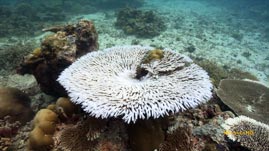Teachers' Domain - Digital Media for the Classroom and Professional Development
User: Preview

Source: Micronesia Conservation Trust
Learn about coral reefs and how changing environments impact them, in these two videos adapted from the Micronesia Conservation Trust. The first video explores how disturbance events (such as coral bleaching, typhoons, and starfish infestation) and land-based pollution affect the coral reefs of Micronesia. Marine biologist Peter Houk explains his research on increasing the resiliency of reefs through ecosystem-based adaptation. The second video looks at the relationship between climate change and reef health. Scientists and community leaders in Ngarchelong, in northern Palau, describe local efforts to protect their marine resources.
Coral Reef Bleaching (Video)
Vocabulary:
Coral reefs are complex ecosystems found in tropical and sub-tropical waters. They are built from colonies of coral polyps, tiny animals related to sea anemones. The reefs provide food and habitat for thousands of species of fish and invertebrates as well as other marine life such as sea turtles. People use coral reefs for fishing, snorkeling, and diving. In addition to being valuable recreational and economic resources, coral reefs protect coasts by acting as a natural buffer against heavy waves.
However, coral reefs are very sensitive to environmental changes. Most reef corals have a symbiotic (mutually beneficial) relationship with a type of algae called zooxanthellae, which live within the coral polyps. The algae use waste products from the corals as nutrients and, in turn, provide the corals with food. If the corals are stressed because of changes in their environment, they expel the algae, which leaves the corals looking white. This is known as coral bleaching. Without the algae, the corals may die.
In 1998, there was a mass bleaching event that led to the death of 16 percent of the world’s reefs. The bleaching event was linked to the El Niño Southern Oscillation, which brought unusually warm waters to coral reefs. Large-scale bleaching events are usually caused by higher water temperatures; localized bleaching can be caused by other factors as well, such as changes in water chemistry, increased sunshine, sedimentation, and disease.
Coral reefs are threatened by both climate change (which is raising ocean levels, temperatures, and acidity) and human activities. For example, agricultural runoff can lead to increased levels of nutrients in the water; excess nutrients can cause an overgrowth of algae or a starfish infestation—both of which kill coral. Land development can increase sedimentation, which blocks essential sunlight. Toxic chemical pollutants (such as mercury and pesticides) can affect ecosystem health. So can the clearing of mangroves. The trees filter sediment and other pollutants from the shore and are nurseries for coral reef fish. Tourism, a key source of income in many areas, can damage reefs from physical contact. Overfishing, particularly of algae-eating species, can also be harmful, as can destructive fishing practices.
Many coastal communities rely on coral reefs as sources of food and income. Their challenge is how to continue to use reefs as resources while reducing the impacts on them. Because of the changing climate, mass bleaching events are predicted to increase in both frequency and severity in the future. A healthy reef ecosystem with a diversity of marine life is stronger and more likely to recover from disturbances. Protective measures, such as establishing managed marine areas and minimizing destructive human activities, can help improve the resiliency of coral reefs.
Here are suggested ways to engage students with these videos and with activities related to this topic.
Class activity: Take students to visit areas where they can see coral reefs. Have them observe the underwater environment using a clear-bottomed box (glass or plastic), which allows them to see below the water’s surface. Discuss what they observe.
Research project—small groups: Have students work in pairs to interview community elders about local coral reefs. What changes have they observed in the communities of fish and other organisms found in the reefs?
Small group activity: Have students work in small groups to start a grassroots campaign to protect and preserve local coral reefs. Students should prepare and present convincing arguments for the value of coral reefs and the costs of their destruction.
 Loading Standards
Loading Standards